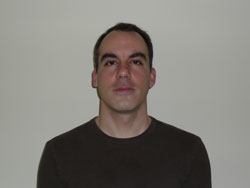Editor’s note:
This is the sixth story in “
Seven Behind Windows 7
,” a series featuring employees who helped build the new operating system.
REDMOND, Wash. – Feb. 8, 2010 – When it comes to energy efficiency, Stephen Berard says computers are like lightbulbs.
“You can leave a lightbulb on all the time, but if you leave the room when the light is on, it’s wasted energy,” Berard said. “What we do in the operating system version of that is to turn the light off when you’re not in the room.”

“I was completely floored when I found out I was selected,” says Steven Berard of his Microsoft Environmental Action Award. “It’s a huge honor. We did a lot of really amazing things in Windows 7, and when I say ‘we,’ I truly mean ‘we.’”
Berard, a senior program manager for the Windows Kernel Team, is the recipient of Microsoft’s quarterly Environmental Action Award for his work making the Windows 7 platform, including Windows 7 running as workstations as part of systems running on Windows Server 2008 R2, more energy efficient.
“I was completely floored when I found out I was selected,” Berard said. “It’s a huge honor. We did a lot of really amazing things in Windows 7, and when I say ‘we,’ I truly mean ‘we.’ There was a big group of folks across Microsoft that were involved.”
Increasing energy efficiency has always been a focus for the Windows team, Berard said. In the past, that has included mobile devices, laptops, and desktop systems. With Windows 7, the energy efficiency focus included computer servers.
Servers consume a lot of energy, and the vast majority of that energy is turned into heat, which then requires air conditioning to cool the machines and to keep them from overheating, he said. This is especially important in datacenters with large numbers of servers.
Windows 7 makes servers more energy efficient than ever—and also more manageable. Administrators can monitor energy consumption and adjust power settings across their organization, reducing the amount of wasted energy.
Berard has been at Microsoft working on energy-efficiency projects for more than five years. Before that, he worked for American Power Conversion for 12 years as a software engineer and architect designing datacenter power-management products.
To make Windows 7 more energy efficient, Berard and his team had to coordinate with partners, customers, and even some competitors in the industry to gain acceptance of their concept. As part of the series “Seven Behind Windows 7,” The News Center spoke to Berard about his work developing power-saving measures for Windows 7.
The News Center: What kinds of power-management features did you work on for Windows 7?
Berard: My main focus for Windows 7 was related to server power management. Our goal was to improve the overall power consumption of servers. We wanted to take the technologies we use in the mobile and laptop space and apply them to servers. As a result, we delivered a server operating system that is more efficient and more manageable than any other version of Windows.
Using Windows Server 2008 R2, administrators are able to monitor energy consumption just like any other performance metric in Windows. This enables them to adjust power settings to suit the needs of their business. Further, using tools like System Center Operations Manager, administrators can manage and monitor literally hundreds of Windows Server systems across their organization.
The News Center: What was the biggest challenge or hurdle you faced working on your feature?
Berard: Our greatest challenge was gaining industry support for our feature among our server partners. In order to provide energy-consumption reporting, we needed support in hardware. Today there is a lot of focus on energy efficiency and green IT. Naturally, as a result, it’s an area of competition. As a result, there were a lot of proprietary solutions in the market and little in the way of standards. What we needed to do was to strike a balance between what we deliver in Windows and what our partners could provide.
Our mission was to create a solution that provided real value to our customers while enabling our partners to build and extend upon it. We didn’t want to replace vendor-specific solutions, but we did need some amount of standardization. Our approach was to engage early with our partners across the entire server ecosystem to gather their requirements and feedback. This required an amazing amount of communication.
The News Center: What’s the thing you’re proudest of in Windows 7?
Berard: Delivering on what we promised, when we promised it. While it sounds trivial, it’s not. People had high expectations of us. I’m extremely proud that our team delivered on our promises.

Berard is a dedicated cyclist, spending much of his free time riding as well as racing for a Seattle-based cycling team.
The News Center: How did you get customer input about Windows 7 power management?
Berard: Microsoft is a part of a number of industry groups such as the Green Grid and Climate Savers Computing Initiative (CSCI). These groups provided an excellent opportunity for us to interface with the industry. We also worked with our server OEM partners very closely. So we were able to get their input, as well as input from their customers. Finally, we worked with our field staff to get direct customer input.
The News Center: Was teamwork important developing power management?
Berard: There were a lot of moving parts that all needed to be in place for us to be successful, so teamwork was absolutely essential. For example, to report energy consumption, we needed the server platforms to support this in hardware. This required development relationships to be set up with our partners. Our development team needed to specify and develop the necessary support in Windows. We coordinated this with our hardware partners and their development teams. And our test team needed to make sure that what we shipped was absolutely reliable. We wouldn’t have been able to do what we did without the enormous effort of all involved.
The News Center: What was a typical day like working on Windows 7?
Berard: It involved a lot of conference calls, lots and lots of them. We had to do a tremendous amount of coordination and evangelism in order to deliver our features. That required a huge amount of communication and coordination. Amazingly, we did the majority of this via teleconference using tools like Microsoft’s Live Meeting rather than jumping on a plane to meet face-to-face. For me, it was an example of the team’s dedication to our environmental goals.
The News Center: What do you need to do your best work?
Berard: Being part of a team with good leadership and peers that are smart as hell is essential. Being able to walk down the hall and bounce ideas off of some really smart people is key. A good team will challenge you and, as a result, help you to deliver your best work.
I also tend to be a pretty intense person, especially when I’m focused on a task or key deliverable. Having a work space where I can close the door and work undisturbed is key for me, not to mention really strong coffee!
The News Center: What’s next for you at Microsoft?
Berard: Right now I’m working in Paris at a Microsoft subsidiary. My wife had a wonderful opportunity to relocate to France for a few years. While it was really tough to leave my group in Windows, it has been a tremendous opportunity for me. I firmly believe that we grow the most when we are forced to step outside of what we know and do something different.
The News Center: What do you do when you’re not working?
Berard: I am a really dedicated cyclist and spend a large amount of my free time riding. For the past five years I have trained and raced for a Seattle-based cycling team. It’s a great way to relieve stress and stay both mentally and physically fit.
My wife and I are foodies, so we also enjoy cooking and entertaining whenever we can. We also love to travel and often spend our vacations in the south of France—usually with our bikes!




